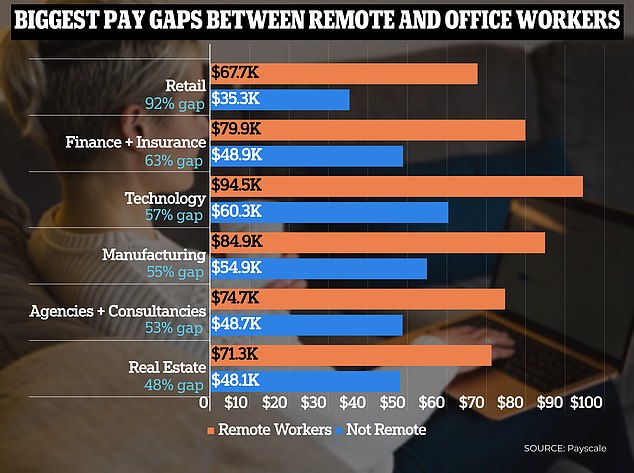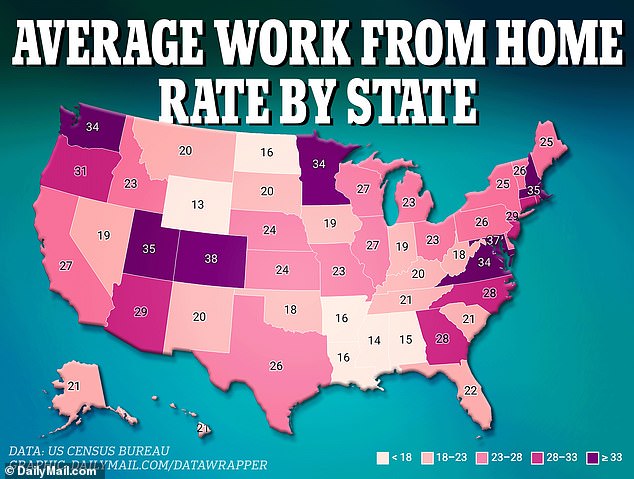The Industries That PAY You to Work from Home: Why Remote Technology and Finance Workers Earn More Than 50% More Than Their Office-Based Colleagues
New research shows that remote workers in several sectors, including the financial and insurance sectors, earn more than office workers.
According to insights from data company Payscale, the pay gap between remote and non-teleworkers in consultancy, manufacturing and technology is more than 50 percent.
According to the findings, retail has the biggest disparity, with employees working from home earning an average salary of $67,700 – a huge 92 percent more than their office-based counterparts who typically earned $35,300.
There is a 63 percent gap between remote and in-office finance and insurance employees, the survey found.
While remote workers in the industry typically earn $79,900 per year, office-based workers have an average annual salary of about $48,900.

New research shows that remote workers in several sectors, including the financial and insurance sectors, earn more than office workers
The sector with the third largest pay gap (57 percent) is technology.
According to the study, remote tech workers earn an average of $94,500, while in-office workers earn $60,300.
To calculate the findings, Payscale surveyed more than 300,000 working U.S. adults between August 2021 and August 2023, defining “remote” as anyone who telecommutes most or all of the time.
It found that manufacturing, temporary employment and consulting workers also experienced a remote work pay gap of more than 50 percent – 55 percent and 53 percent respectively.
According to the study, the pay gap between remote and office workers in the real estate sector was 48 percent. Employees working from home earned an average of $71,300, while office-based colleagues earned approximately $48,100 per year.
Payscale data analyst Jackson Gruver told DailyMail.com: ‘The main reason for these pay gaps is occupational differences, rather than discrimination, between remote and non-teleworkers.
“Employees who don’t work remotely are more likely to be in lower-wage positions that require on-site work, such as store clerks and bank tellers. White-collar jobs that typically pay higher wages, such as software developers and analysts, can be done remotely.”
These pay gaps also imply that companies with return-to-the-office mandates are limiting remote opportunities to senior, specialized positions, Ruth Thomas, a compensation strategist at Payscale, told me. CNBC.
According to a questionnaire Earlier this month, employment marketplace ZipRecruiter said 72 percent of companies lost valuable employees as a result of reducing their remote work offerings.
Remote workers have lower overhead costs and access to a broader pool of potential employers, which could translate into a higher take-home salary, Thomas said.
Those who work from home tend to be experienced professionals who are further along in their careers, giving them more ability to negotiate flexible work arrangements, she says.

Since the rise of working from home during the pandemic, many companies have scrambled to get employees back into the office
It comes as separate research shows which states still have the largest share of residents working from home.
Since the rise of working from home during the pandemic, many companies have scrambled to get employees back to the office.
Despite this, remote work is still common in the US.
According to the last two Census Bureau Household Pulse SurveysColorado has the highest percentage of people still working from home of any U.S. state, with 38.3 percent of households reporting someone working from home at least once a week.
In the US, seven states – and Washington DC – have a homework rate of more than 33 percent.
Maryland has the second-highest percentage of households where someone worked from home at least one day in the past seven days: 36.9 percent.

According to data from the US Census Bureau, Colorado is the state with the highest percentage of people still working from home
About 34.9 percent of households in Utah have someone working remotely, 34.7 percent in Massachusetts and 34.3 percent in Minnesota.
On the other end of the spectrum, Wyoming employees are the least likely to work from home.
Only 12.9 percent of households had someone working from home in the past week in the state – where key industries include mining, agriculture and manufacturing.
Mississippi has the second-lowest percentage of remote workers at 13.5 percent, followed by Alabama at 14.8 percent, North Dakota at 16 percent and Arkansas at 16.2 percent.
States like Mississippi and Louisiana – where 16 percent are working from home – have not been as able to widely embrace remote work due to their reliance on personal industries, including manufacturing and oil and gas.
Overall, about 26 percent of U.S. households have someone who works remotely at least one day a week — down from an early 2021 peak of 37 percent.
